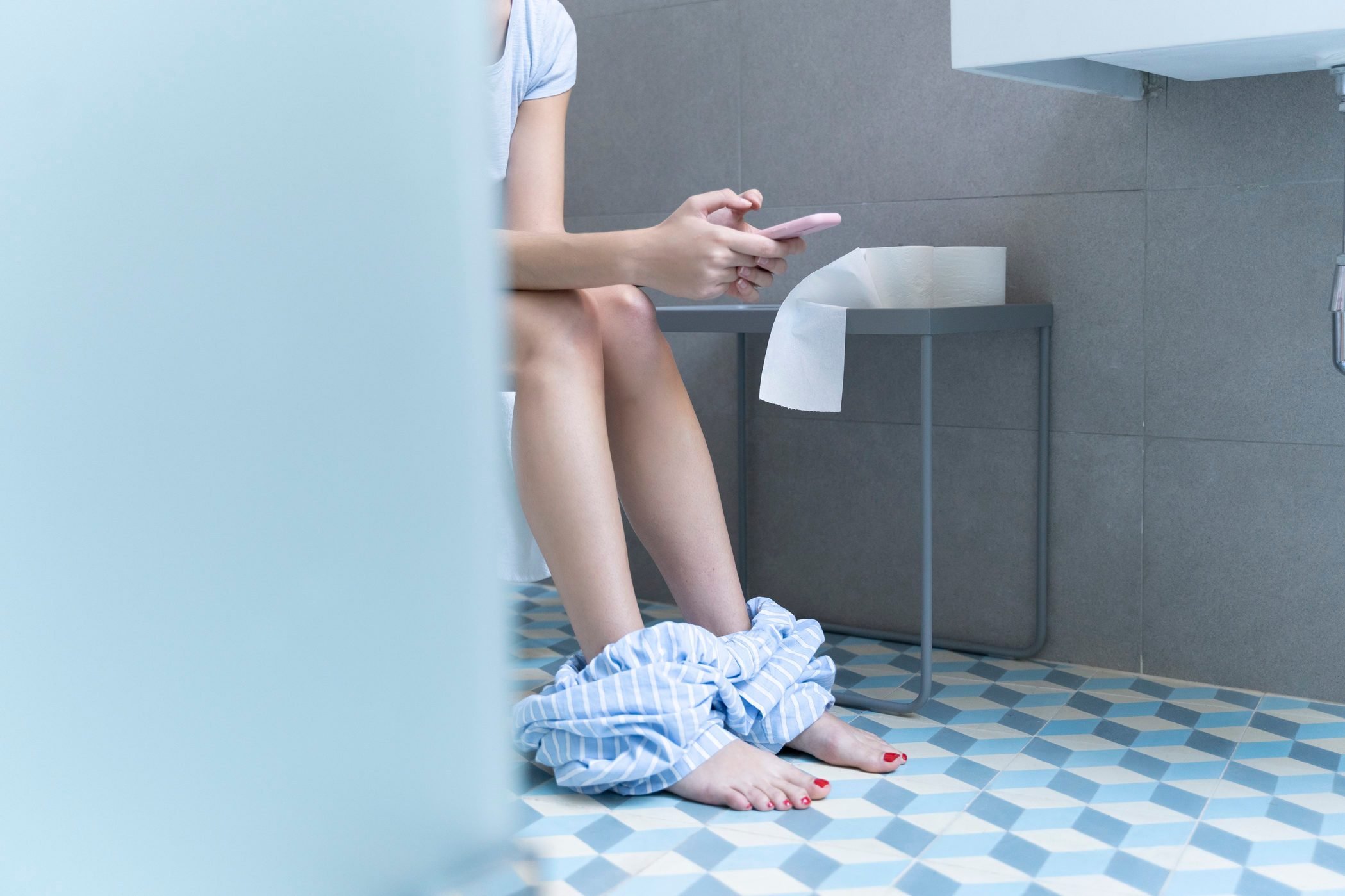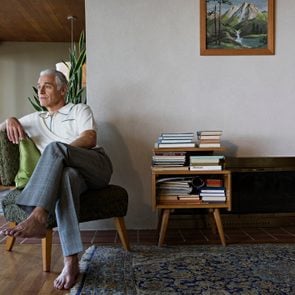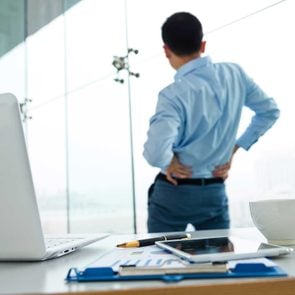Can Constipation Really Cause Lower Back Pain?
Updated: Aug. 18, 2022
Constipation can cause back pain, and if you already have low back pain, blocked up bowels can make it worse. Here's why you may be hurting—and what to do about it.
Constipation and low back pain
If you have lower back pain, you’re not alone. The Cleveland Clinic reports that around four out of five Americans experience lower back pain at some point in their lives. One reason the problem is so common is that the list of potential causes is long. Your back contains many structures that can cause or contribute to pain, including bones, muscles, joints, nerves, tendons, disks and ligaments. These can become damaged from trauma, aging, obesity, overexertion, and underlying diseases, among other factors. (Here are some other surprising reasons for back pain.)
Your lower back’s proximity to other organs and body parts, like the colon, makes it a prime target for referred pain, including from constipation.
Here’s a closer look at constipation, the causes of constipation with lower back pain, and treatment options for relief.
Get The Healthy @Reader’s Digest newsletter
What is constipation?
Constipation is defined as having three or fewer bowel movements in a week. If you are constipated, your stool may also be hard, dry and painful to pass.
“Constipation may cause lower back pain because stool buildup can cause pressure on the colon or rectum, which can refer pain to the lower back,” says Yili Huang, DO, director of the Pain Management Center at Northwell Health’s Phelps Hospital in Sleepy Hollow, New York. Pressure from constipation-related abdominal bloating, gas and swelling may manifest as low back pain, too.
If you already have back pain, constipation may worsen it. Pushing too hard to pass a bowel movement can increase pressure on nerves and aggravate your back. It’s also possible that the prescription narcotics you take to treat your back pain are causing constipation, according to the U.S. Pain Foundation.
Causes of constipation with back pain
“If constipation is the culprit of your back pain, the pain is likely along the sides of your lower back,” says Elena Maser, MD, an assistant professor at the Icahn School of Medicine at Mount Sinai and a gastroenterologist at the Feinstein IBD Center at Mount Sinai Hospital in New York City.
Another way to tell? “This pain should resolve if you pass one or more banana-sized stools,” Dr. Maser says.
Constipation may be picked up by your primary care doctor when you are evaluated for low back pain. “Your doctor will likely order an X-ray,” Dr. Maser says. “You can see large stool buildup on the films if you look for it.”
Keep reading for the possible reasons you’re constipated—and how to find relief.
Pushing Through Back Pain: What Pain Doctors Need You to Know

Low-fiber diet
Fiber increases the bulk of your stool, making it easier to pass, which is why low-fiber diets have been linked to constipation and low back pain.
Treatment
The Academy of Nutrition and Dietetics suggests 25 grams of fiber per day for women and 38 grams for men. High-fiber foods include fruits, vegetables, whole grains, and beans.
What you don’t eat is also important, explains Dr. Maser. Foods with little to no fiber—think processed foods, chips, and cookies—won’t help you become more regular, which won’t relieve back pain from constipation. These unhealthy foods may also lead to weight gain, which can cause or worsen low back pain.
10 Foods with More Fiber Than Broccoli
Dehydration
Not drinking enough water can cause or worsen constipation, and lead to low back pain.
Treatment
It’s important to drink enough water or unsweetened beverages throughout the day to make sure your stool stays soft. Along with ample fiber intake, water makes stool easier to pass, Dr. Maser says. According to the U.S. National Academies of Sciences, Engineering, and Medicine, an adequate daily intake of water is 11.5 cups (2.7 L) for women and 15.5 cups (3.7 L) for men. Just remember that fruit, vegetables, juices and even coffee all contribute to your daily hydration.
Here’s How Much Water You Really Need in a Day, with Nutritional Scientists’ Latest Wisdom
Lack of physical activity
You’ve got to move to have a movement. Regular physical activity keeps all of your muscles—including those involved in passing stool—in good shape.
Treatment
Aim for 30 minutes a day of moderate physical activity, such as brisk walking, at least five days a week, along with some strength training, according to the CDC. Walking can also help with your back pain.
Is Walking Good Exercise? Fitness Pros Explain Why It’s an Ideal Workout
Medications
Your medications, including those you take for low back pain, may cause constipation, which can worsen your pain. The list of medications with constipation as a possible side effect includes narcotics; some antacids; antidepressants; tranquilizers; iron or calcium supplements; anticonvulsants for seizure disorders; blood pressure meds; and drugs that treat the symptoms of Parkinson’s disease, according to the American Gastroenterological Association.
But that doesn’t mean you should stop taking a medication, even if it’s the cause of your backup. Talk to your doctor and make sure they’re aware of the medications you take on a daily basis. (That includes supplements!) If you are taking a medication for back pain which is causing constipation, your doctor may be able to prescribe a different one or give you advice on how to relieve your constipation, Dr. Maser says.
14 Medications Pain Doctors Try to Avoid
Irritable bowel syndrome
Irritable bowel syndrome (IBS) is marked by constipation and/or diarrhea, cramps, pain, bloating and fatigue, and also travels with low back pain, according to the International Foundation for Gastrointestinal Disorders.
Treatment
Discuss your IBS symptoms with your doctor to see what else you can do to feel better. There are many treatments you can try, including medication, stress management and relaxation techniques.
8 Ways to Relieve IBS Symptoms Naturally
Bowel obstruction
“When lower back pain is associated with sudden changes in bowel or bladder control, it is important to seek medical attention to ensure that it is not related to dangerous neurologic damage,” Dr. Huang says.
Known as cauda equina syndrome, this rare disorder occurs when nerve roots in the lumbar spine are compressed. These nerve roots (the cauda equina, hence the condition’s name) control bladder and bowel function, according to the American Academy of Orthopaedic Surgeons. (These are other signs that your back pain is an emergency.)
Treatment
Your doctor may order imaging studies, like an X-ray, MRI or CT scan, to diagnose the disorder. You may need surgery to remove material pressing on the nerves and prevent permanent damage.
Colon or rectal cancer
Sometimes a tumor may block your bowels, leading to constipation and back pain. Other symptoms may include cramping, vomiting, bloating and the inability to pass gas.
A change in your bowel habits can be a sign of colon or rectal cancer, especially if it lasts for more than a few days and occurs with other symptoms, such as rectal bleeding, blood in your stool and unexplained weight loss.
The best way to stay ahead of colon cancer is to make sure you undergo regular screening with colonoscopy.
Treatment
If the blockage is complete, surgery may be needed to remove the tumor, according to the U.S. Library of Medicine. Depending on your type and stage of cancer, as well as if it’s spread, you may need additional treatment, such as chemotherapy or radiation, according to the National Cancer Institute.
If You Eat This Food, You Could Reduce Your Risk of Colorectal Cancer by 17 Percent
Pelvic floor dysfunction
Constipation may not be related to your diet and lifestyle at all. Sometimes it’s caused by a lack of coordination between all the muscles involved in having a bowel movement—a condition known as pelvic floor dysfunction, Dr. Maser says.
See a gastroenterologist to learn what type of constipation you have, says Dr. Maser. It may be related to your diet or lifestyle, or it could be caused by pelvic floor dysfunction.
It’s an important distinction, as eating more fiber to increase the bulk of the stool and drinking more water to help it pass won’t work for constipation caused by pelvic floor dysfunction. “It could make it worse,” she says.
Treatment
Treatment involves the use of biofeedback to learn to be more aware of bodily movements or sensations, or pelvic floor physical therapy, which retrains these muscles, the American Gastroenterological Association explains.
Other treatment options for constipation with back pain
Treatment of constipation with back pain typically starts with a capful of an over-the-counter laxative, such as Miralax (polyethylene glycol 3350 powder), taken daily for eight weeks.
“It is gentle enough that people will do it and aggressive enough that it will work,” Dr. Maser says. Miralax works by drawing water into the colon to soften the stool and may stimulate the colon to contract. (Here are 11 surprising home remedies for constipation relief.)
Once the initial bout of constipation is resolved, other methods, including eating a high-fiber diet, drinking more water, making medication changes, or learning biofeedback, can help prevent it from coming back.
The last word
Constipation often travels with low back pain. Your first step is to figure out if the constipation is the chicken or the egg. Identifying and treating the underlying cause will benefit your constipation and back pain.
If your constipation is caused by dehydration, lack of dietary fiber, or physical inactivity, there are steps you can take to get regular. “Water helps,” Dr. Maser says. “Exercise helps. A high-fiber diet helps. Eating meals at regular times helps, as does taking time to pass stool and not rushing it.”
Most of the time, constipation is nothing serious, but if you are also bleeding from your rectum, you notice blood in your stool, and you’re losing weight without trying to, check with your doctor to see what is going on.
For more wellness updates, follow The Healthy on Facebook, Instagram, and Twitter. Keep reading:
- Eating More of This Can Improve Your Gut Health, Says New Science
- Have Acne, Eczema or Psoriasis? Know This About Your Monkeypox Risk, and a Doctor’s Prevention Tips
- Here’s How Long You Need to Walk to Lower Your Blood Sugar, New Research Finds
- Drinking This Beloved Juice Every Day Could Reduce Your Heart Disease Risk




















